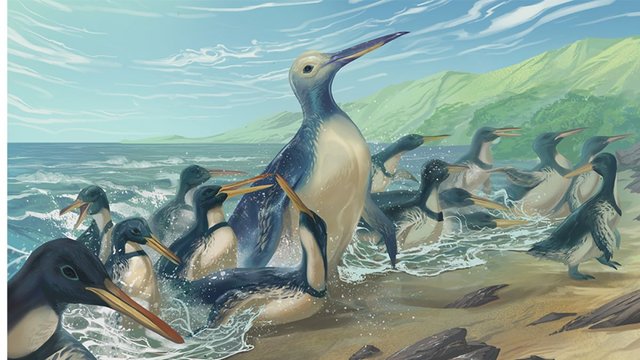Researchers in New Zealand have unearthed fossils from two previously unknown ancient penguin species. One of the new species is the largest penguin ever discovered.

Scientists have unearthed the fossilized remains of the largest ever known penguin on Earth, a 340-pound (154 kilograms) behemoth that glided through the oceans around what is now New Zealand more than 50 million years ago.
The fossils of this newfound species, Kumimanu fordycei, were found alongside eight other specimens inside beach boulders in North Otago, on New Zealand's South Island. Five of the remaining specimens belonged to another newfound species, Petradyptes stonehousei, one belonged to another known giant penguin, Kumimanu biceae, and two were unidentified. The rocks dated to between 59.5 million and 55.5 million years ago.
In a study, published Feb. 8 in the Journal of Paleontology(opens in new tab), researchers estimated the weight of the two newfound species based on the size and density of their bones compared with those of modern penguins. The team found that P. stonehousei weighed around 110 pounds (50 kilograms), which is slightly above the weight of living emperor penguins (Aptenodytes forsteri). K. fordeycei would have weighed more than three times that, tipping the scales at a whopping 340 pounds. For comparison, the average 20-year-old man in the U.S. weighs 198 pounds (90 kg), according to Healthline(opens in new tab). (Without a near-complete skeleton, the researchers weren't able to estimate the body length of the new species.)
According to our analyses, K. fordycei is the biggest penguin currently known," study first author Daniel Ksepka(opens in new tab), a palaeontologist and curator at the Bruce Museum in Greenwich, Connecticut, told Live Science in an email.
Related: Kids discover giant penguin's fossil skeleton in New Zealand
Previously, the largest penguin on record was Palaeeudyptes klekowskii, which lived around 37 million years ago in Antarctica, weighed 256 pounds (116 kg) and stood at around 6.6 feet (2 meters) tall, earning it the nickname "colossus penguin." The next largest, K. biceae, weighed around 267 pounds (121 kg) and had a body length of around 5.8 feet (1.8 m).

The two new species were likely among some of the first ancient penguins. The new discovery could shed light on how the group evolved over time.
The new species had "relatively primitive flipper bones," Ksepka said. "In many ways [they] resemble those of birds that can both fly through the air and propel themselves underwater with their wings, such as auks and puffins." (But neither of the new species could fly.)
Penguins likely lost the ability to fly in favor of swimming around 60 million years ago, not long before the new species likely emerged. So these early penguins had not yet evolved the super-efficient flippers seen in younger ancient penguins and their living relatives.
The enormous size of K. fordycei shows that gigantism evolved early on in the penguin lineage, Ksepka said. "It goes to show that the advantages of large size, such as more efficient thermoregulation and diving, probably exerted very strong selective pressure on penguins soon after they lost flight."
The unique environmental conditions of ancient New Zealand played a key role in the emergence and success of giant penguins, the researchers speculate.
Related: Noodle-necked swimming dinosaur may have been a diving predator like a penguin
"New Zealand is (and has been) a great place to be a penguin," Ksepka said. "There are good feeding grounds offshore for marine birds, and there were no land mammals other than bats in New Zealand before humans arrived, which makes for safer nesting areas."
Giant penguins like K. fordcyei disappeared around 27 million years ago, according to Australian Geographic(opens in new tab). What caused their extinction is still an "unresolved question," but it is likely that the enormous birds were eventually outcompeted by marine mammals of similar size, Kspeka said.
K. fordcyei may be the largest known penguin so far, but it's possible that even larger birds roamed New Zealand.
"The size of K. fordcyei doesn't necessarily mean there wasn't an even larger species that is yet to be discovered," Ksepka said.